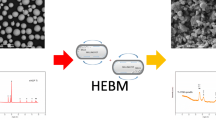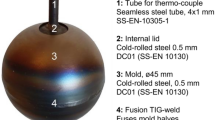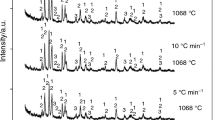Abstract
Results on the thermal conductivity of powders of monoclinic zirconia as a function of the grain size are presented. It is established that of all the investigated sintered powders of monoclinic ZrO2 the 1 – 0.5-mm and 2 – 1-mm fractions have the lowest thermal conductivity and the least apparent density (2.190 and 2.262 g/cm3). Fused powders of monoclinic and stabilized ZrO2 have a higher thermal conductivity than their sintered counterparts. Powders prepared from monoclinic ZrO2 with a burning-off addition of polystyrene have larger pores in the grains, which increases the share of the radiation component in the heat transfer, and hence their thermal conductivity is higher than in powders obtained by sintering pure monoclinic ZrO2. For the same reason, powders from void granules of the 3 – 0.5-mm fraction have a higher thermal conductivity than sintered monoclinic powders of ZrO2.
Similar content being viewed by others
References
A. A. Kaminskii and V. V. Osiko,Izv. Akad. Nauk SSSR, Neorganicheskie Materialy,III(3), 417–463 (1967).
D. M. Shakhtin, V. I. Penezhskii, A. G. Karaulov, et al., “Thermal conductivity of corundum, high-alumina, magnesia, zirconia, and chromium oxide refractories in the interval of 400 – 1800°C,”Ogneupory, No. 5, 16 – 20 (1982).
G. E. Kalita,Gornorudnaya Metallurgicheskaya Promyshlennost', No. 3, 41 – 42 (1982).
A. G. Karaulov, A. A. Eltysheva, Yu. S. Mayauskas, et al., “Investigations of the evaporation of MgO and ZrO2 in a reducing medium,”Ogneupory, No. 2, 49 – 53 (1971).
A. G. Karaulov, V. A. Kobzar'-Zlenko, V. A. Aslanov, et al., “Refractory heat-insulating material for high-frequency installations for growing single crystals,” in:Production of Special Refractories, Collected Works of the Ukrainian Research Institute of Refractories [in Russian], Metallurgizdat, Moscow, No. 3, 61–66 (1976).
A. G. Karaulov, “Electrical conductivity of zirconia,”Elektrotermiya, No. 35, 12 – 14 (1979).
D. S. Rutman, I. L. Shchetnikova, T. S. Ignatova, and G. A. Semenov, “To the problem of evaporation of the components of zirconia ceramics,”Ogneupory, No. 1, 49 – 52 (1968).
V. V. Pustovalov,Thermal Conductivity of Refractories [in Russian], Metallurgiya, Moscow (1966).
Author information
Authors and Affiliations
Additional information
Translated from Ogneupory, No. 1, pp. 26 – 29, January, 1995.
Rights and permissions
About this article
Cite this article
Karaulov, A.G., Shlyakhova, T.M. & Akselrod, E.I. Zirconia refractories. Refractories 36, 29–32 (1995). https://doi.org/10.1007/BF02226984
Received:
Issue Date:
DOI: https://doi.org/10.1007/BF02226984




